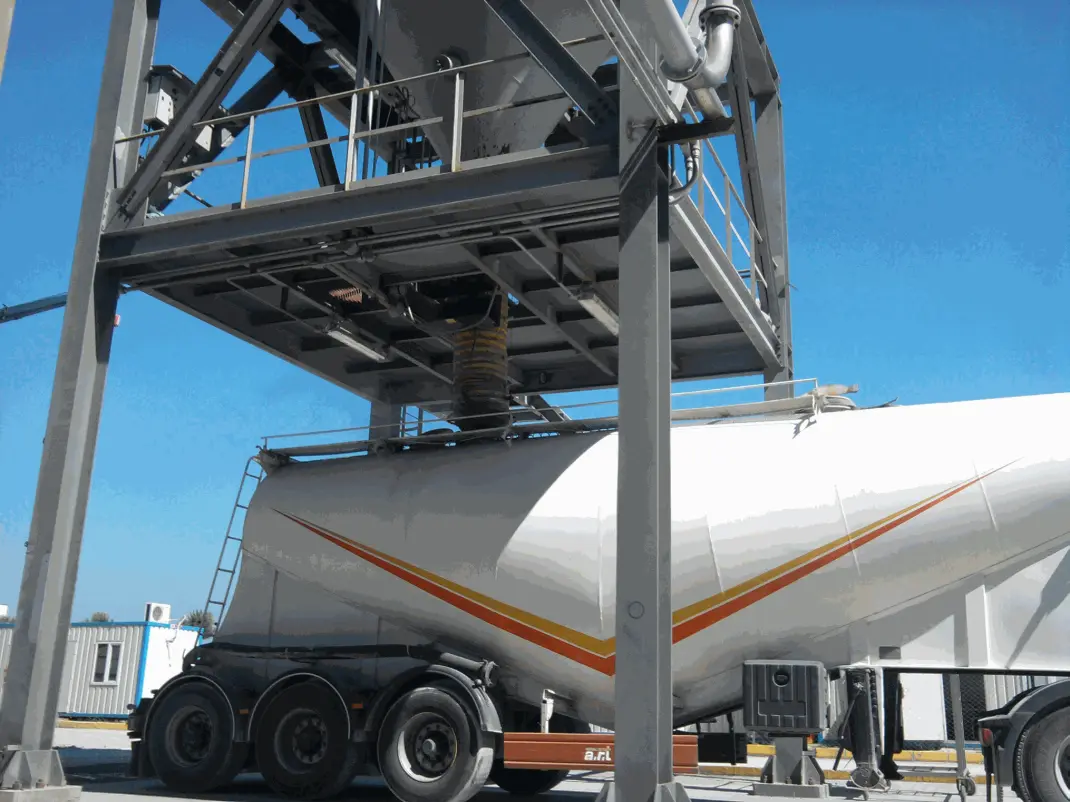Silo Discharge to Truck
Discharging bulk materials from a silo into a bulk truck is a widely preferred operation in logistics chains. This is especially common in industries where materials are stored in vertical silos before being transported to customers or secondary processing sites. This configuration ensures controlled, dust-free, and efficient loading of tankers or open trucks with bulk solids in powders or granular form.

How the System Operates
• Discharge Activation:
Bulk material stored in the silo is discharged through either a gravity-based flow system or one with mechanical assistance, typically activated via a control panel. Discharge can occur continuously or in batches, depending on operational requirements.
• Flow Assistance (Optional):
For bulk solids with poor flow characteristics (such as fine powders or sticky substances), flow aids like air pads, vibrators, or silo aeration pads are installed at the silo to enable smooth discharge.
• Loading Control:
A loading spout or telescopic chute extends into the inlet of the bulk truck. This device is often equipped with dust skirts and level sensors to manage the flow rate and prevent overfilling.
• Dust Management:
During the discharge process, airborne dust is captured by an integrated dust collector or directed to the truck’s filter system. This mechanism helps maintain a clean and safe loading area.

Key Components
• Discharge Gate or Valve: Material flow from the silo is controlled using slide gates, rotary valves, or butterfly valves. These can be operated either manually or through automation, depending on the system design.
• Telescopic Chute: Adjustable, retractable bulk handling equipment that transfer bulk material into the truck while minimizing dust and spillage. Often equipped with level sensors, flow control features, and dust skirts.
• Flow Aid Devices: Equipment such as silo aeration pads, bin activators to help dislodge compacted or cohesive materials.
• Weighing Systems (Optional): The system can include inline load cells to accurately monitor material flow and achieve the desired truck loading weight.
• Dust Collector: Installed on the silo, these systems collect fine particles during the discharge process and prevent them from contaminating the atmosphere.

Advantages & Benefits of Silo Discharge to Truck
- Fast and Controlled Loading: The system enables quick and efficient loading of bulk trucks, minimizing loading and waiting times. Manual intervention is minimized through automation, improving operational productivity.
- Dust-Free Environment: Integrated filtration systems capture airborne particles during the loading process. This system protects workers and ensures compliance with workplace air quality regulations.
- Minimized Product Loss: Accurate filling mechanisms help control the material flow into the truck. This mechanism reduces the risk of spillage and minimizes overall material waste.
- Improved Safety: Automated control systems are equipped with safety features such as level monitoring and overload safeguarding. These systems help reduce human error and improve workplace safety.
- Customizable Design: The system can be tailored to accommodate various truck sizes, bulk materials, and specific discharge rates. This flexibility ensures compatibility across different operational needs.

Industry-Specific Examples
- Construction Materials: Construction materials such as cement, fly ash, and lime are discharged from vertical silos directly into bulk tanker trucks. High-capacity loading chutes equipped with integrated dust filters ensure efficient transfer while minimizing airborne dust.
- Chemical Industry: Powdered chemicals such as sodium bicarbonate and citric acid are loaded with high precision. Controlled discharge valves combined with weigh-scale feedback systems maintain accurate batch weights and reduce material loss.
- Pharmaceutical Industry: Fine powders and granules are transferred into sealed containers to prevent contamination. Specialized dust control and automatic cleaning systems ensure strict adherence to regulatory requirements.